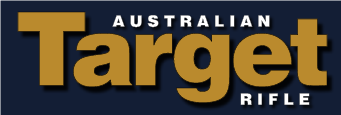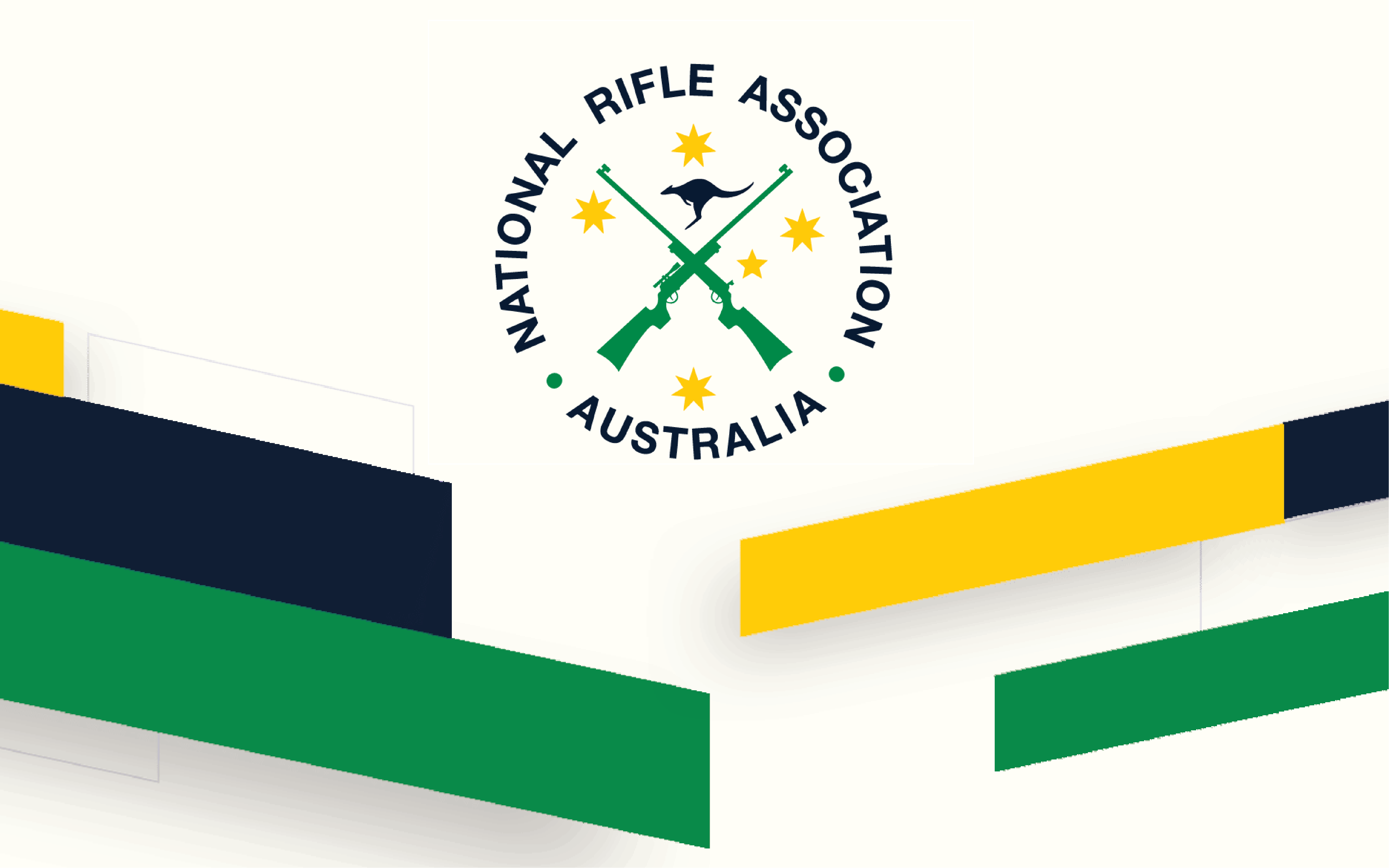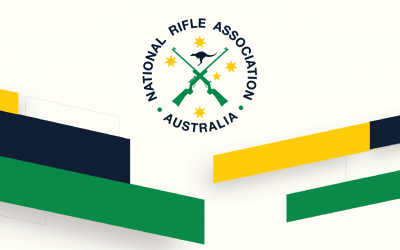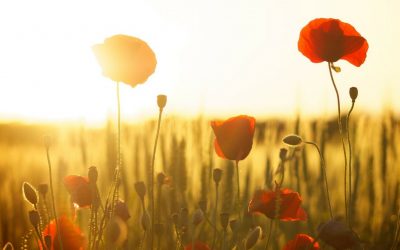Frederick George Harrison was born 1882 in Mt Gambier, South Australia to parents Thomas Lawrence Harrison and Emily Agnes O’Brien. Other children in the family were Elizabeth b1884, Albert, b1886, Leslie b1888, Percy b1891, Arthur b1894 and Edith b1897.
The NSW BDM gives us that Fred’s bother Leslie was born in Lismore in 1888 so the family had moved there from Mt Gambier in the period 1882 to 1888. Fred married Josephine Vaskess in 1919 in St Leonards.
We first find Fred having success in rifle shooting in 1900[1] where he won a tyro match at age 17 with a possible.

By 1902 we find Fred appearing more and more often in the prize lists of rifle matches and around 1907/1908 he had moved to Sydney where we find him then a member of the Randwick Rifle Club. A short timeline of Fred’s rise in shooting prior to WW1 sampled from the Trove Newspaper site is shown below.
1902[2] We see Reservist FG Harrison of the Lismore Rifle Club winning “The Finn” and placing in “The Treasurer” at the National Rifle Meeting at Randwick.
1905[3] In the NSW Kings B Series, Harrison of Lismore took 3rd place.
1907[4] In October Fred was still shooting for Lismore and the following note in the Goulburn Evening Penny Post is noted.
Owing to mistakes made by scorers and check scorers, the positions of some of the men in the King’s aggregate were wrongly given in the prize-list published on Thursday night. In the revised list F. G. Harrison, of Lismore, with a total of 232, takes second place; while W. Linn, of Orange, gets third; W. O. Raven, of Great Britain, was fourth; Sgt.-Maj. Brithan, of Victoria, fifth; and Sgt. W. Tatlow, of Great Britain, sixth. Regimental Quartermaster – sergeant Smythe (University Scouts) won the champion medal, which was awarded for the highest score in the King’s, Longfield, and Holmes Aggregate.
1908[i] Here we find Fred shooting for Randwick Club in a Team to Lithgow and Portland.
The Randwick Club is sending a team, of 12 men to Lithgow and Portland to take part in matches against Lithgow on Friday at 500 and 600 yards, and on Saturday over- the same ranges with- Portland. Captain. J R. Wallace is. taking -the following men: E. W. Hearne, F. G. Harrison, F. Masters, W. Webster, J. Mason, J. Nicholas, R. McLean, C. A. Hammond, D. H. Mitchell, F; Greer, and . R. Hammond. The club will enter three- teams for the Metropolitan Association’s’ grade matches, which commence on January 9. The half-yearly meeting will be held in the local Town Hall on Tuesday.
1909[6] Fred won the Randwick Club Championship just a year or so after moving to that club.

1910[7] At the VRA King’s Fred took second place.

1912[8] [9] We have several newspaper articles about Fred Harrison travelling to Bisley in 1912. It seems that the “team” despatched was not an official one with members invited to attend.
With funds not being available it seems that other means to travel were employed such as working their passage. An article in the Border Morning Mail tells us Fred Harrison worked as a stoker for the trip. The Federal Government were criticised for not supporting the team as they had promised £2000 each year to assist however the money had been spent on improvements to the VRA Range.


The article below is taken from the Northern Star (Lismore) 26 July 1912.
RIFLE SHOOTING.
A LISMORE RIFLEMAN ABROAD.
Writing to his parents from GLASGOW under date June 20th, Mr. Fred. G. Harrison, who is doing so well at Bisley, reports all well, and that the Australian party of shooters are having a pleasant time. He says the Stockholm trip was abandoned owing to the more important fixture at Bisley following closely upon the Olympia Games. Four days after arrival Harrison and some of the other Australians took part at the Darnley Rifle Meeting, where all distinguished themselves, especially the Lismoreite. On the first day Hattersley and Harrison each secured prizes of £1 in the Bannockburn. The former won £2 in the City of Glasgow, out of which Edmond also took £1. Harrison was again amongst the winners of the Stock Exchange prizes, his div. being £l as the result of a score of 34-one off the possible. In the contest for the Scottish National Rifle Championship Harrison proved his ability as a marksman, as the following extracts from a copy of the Glasgow “Herald” will show. “Among those who were, included in the last squads was F. G. Harrison, a tall, bronzed Colonial. At the 200 and 500 yards he dropped only two points both at the shorter distance. If he was even to equal the total of Fitz (the leader) he would require to make the possible at 600 yards. And with true Australian pluck he proved, equal to the occasion. He made the possible, and, as subsequent events proved, tied for the silver medal, for none of the other competitors, equalled, let alone surpassed, the totals of the Glasgow man (Fitz) and the Colonial. The tie was shot in the afternoon, when, with rain falling in torrents, Fitz and Harrison met at 600 yards to decide who should have the honour. The conditions were a sighter, and three shots, and the, shooting was watched with great interest. Fitz sighted with a bull, which he converted into a counting shot. Harrison opened with a magpie, but began to count with a bull. Fitz went to the -inner with his next- shot,1 and-Harrison was even less fortunate, his bullet going to the magpie. The Glasgow man ended with a bull, as did Harrison,’ the totals being Fitz-14, Harrison 13. Fitz’s victory was popular, and the first to congratulate him was his friend and rival from overseas. The winner and Harrison scored 103 each in the first stage. Edmonds put up 96, and Lawless and Hattersley 95 each. The conditions of the second stage were ten rounds at 500 yards, and fifteen rounds at 600 yards. Writing of this stage the “Herald” says:-“All began steadily, and when the 500 yards range was done with Harrison had a card of 48, which, added to his total in the first stage, gave him a score of 151, and placed him ahead of all others. Fitz and Kerr came next with 150 each. When the contest began at 600 yards the wind was very troublesome. At the outset interest was centred in the doings of Harrison. On leaving the initial distance everything seemed to be in his favour, and he was looked upon as the likely winner. Unfortunately, he omitted to adjust his sight to the longer range, and he only discovered this after he had fired his sighting shot. No response came. The competitor who was squadded beside Harrison looked inquiringly at him. Harrison shook his head sadly and explained the circumstances, and told the other man to carry on. The Australian’s next shot was a magpie, and after that misfortune dogged him till the close of the competition. Harrison had many sympathisers, but he seemed less perturbed than any of those who condoled with him, and he made many friends by the sportsmanlike way in which he looked upon his mishap.” The contest was eventually won by Fitz with a ‘ grand total of 220, Gray (219) being second. Harrison (214) finished eighth, for which he received £3 and the silver badge, and besides, was on a “fiver” with the winner. As our cables, of the past few days show, the young Lismoreite is keeping his end up at Bisley a fact which classes him as one of the most brilliant riflemen in the world.
1913[10] In this year Fred Harrison was selected as one of NSW’s three representatives in the Australian Bisley Team. The other team members selected were A. Cutler of Bathurst and A.C. Blacklow of the 29th Regiment. The two reserves were well respected riflemen, Harry Motton and David McAlister. The team went on to win the Australian’s first McKinnon.
BISLEY[11] RIFLE MEET1NG
The McKinnon Cup. Won by Australians. A Popular Victory. London, July 18.
At the Bisley Rifle meeting today the McKinnon Cup was won by Australia, with a score of 1,533. Scotland was second with 1,504, and England third with 1,496, England led at the first stage, with Scotland and Australia three and four points behind respectively. At the next stage England fell to pieces and Australia went ahead.
The ‘Times’ commenting on the match says : ‘The victory was well deserved. It is the first win for Australia in the history of the event. The team, though young, shot with remarkable consistency. Blacklow finished with 11 bulls-eyes, which was a very fine performance. Australia year by year are being recognised as very fine sportsmen, and their victory today was very popular.’

1914 The last Australian Bisley Team prior to WW1[12] again included Fred Harrison along with David McAlister and A.W. Parsons for NSW. The emergency reserves were Harry Motton and J Stinson.
An article[13] in May of 1914 in the Saturday Referee includes notes from a letter from Fred Harrison while they were stopping off in Hobart along with other Bisley related news including the raising of funds for a “Hut” at Bisley.
In June of 1914 it was reported[14] that Fred was shooting at Darnley at the Scottish Rifle Association matches in a first place tie with J.P. Somers who was to Captain the British Team about to visit Australia.
A highlight of the 1914 Team’s visit was the winning of the McKinnon and the Kolapore.
In an article in “the Winner” an interview with Colonel Merrett gives us some insight into the Bisley Team’s achievements:
Bisley Team’s achievements:
ACHIEVEMENTS[15]
As for the achievements of the team, one realises what they are in the knowledge that Colonel Merrett takes back to Australia with him in the Mooltan the Mackinnon Cup and the Kolapore Cup. won by the team; the All-Comers’ Aggregate Cup won by Reservist Cross and the Territorial Service -Aggregate Cup- and the-Belgian Cup won by Reservist McAlister. To this fine collection may be added the Empire Day Challenge Cup, won by the 16th Infantry of Newcastle, N.S.W. A11 these trophies Australia is entitled to hold for a year. The Bisley team men have, in addition, won the ‘Graphic’ Cup, and the King’s Bronze Medal, taken third and fourth place in the final for the King’s Prize, second place in the Barlow, second in the Secretary of State Match, third in the Grand Aggregate, and fifth in the Service Grand Aggregate. And since we wrote last week, Reservist McAlister has won the Territorial Aggregate. The cash winnings at Bisley amount to about £370. McAlister and Cross being well at the head of the list.
In addition, the same article tells us that Fred Harrison often led off the teams:
“I should like to say that much credit, is due to Harrison (N.S.W.) in always firing the first shot at all ranges, for the purpose of getting both wind and elevation, as sighting shots were not allowed.” “Did you always find his lead good?”. “Invariably, because, he is such a sterling shot, and the team had the fullest confidence in his judgment.”

1915-18 World War 1 Service
Fred Harrison and the 1914 Australian Bisley Team were still in England at the outbreak of WW1. While they volunteered to enlist it was not possible to do so at the time and they were forced to return to Australia to sign up.
After returning home, Frederick enlisted into the AIF on 27th July 1915 at Liverpool. On his attestation papers he gives his military experience as Militia Reserve – Randwick, with 2 ½ years in the Literary Institute Rifle Club, 10 years in the Lismore Rifle Club and 4 ½ years in the Randwick Rifle Club. He was 5’ 10 ½“ in height, dark complexion, blue eyes and brown hair. He gave his age as 32 years and 10 months and that his vocation was “Armourer”. Fred had undertaken a 5 year apprenticeship with James Brown who appears to have been furniture makers in Lismore. Fred’s brother Albert was also apprenticed to the same company, Brown and Jolly.
In Dec 1915 he arrived in Suez on board HMAT Beltana. He joined the 30 Battalion Ordinance Corps and was promoted Armourer Sgt on the 16th September 1915. He arrived in France via Marseilles on the 23 June 1916. Most of his time served during the war appears to have been in France. In February 1918 Frederick was promoted Armourer Staff Sergeant.
On the 6th Jan 1919 Frederick was Mentioned in Despatches (27th Dec 1918 in the London Gazette) for conspicuous services during the war.

Three of Fred’s brothers also enlisted in the war, Albert who was also an Armourer Sergeant, Arthur who was captured by the Germans and spent some time as a POW, he also enlisted in WW2, and Percy who rose through the ranks from a private to 2nd Lieutenant by the end of the war.
Bisley AIF Team of 1919
At the end of the war, Fred Harrison and Stan Edwards were appointed selectors and tasked with organising an Australian Team to be made up of teams selected from 25 AIF men to compete at Bisley in the 1919 matches.
Australians at Bisley.[16]
The Melbourne Argus supplies some interesting information regarding the Australians at Bisley, and readers of The Journal -will notice some of this has already appeared in this column. The Bisley matches next month will claim the attention of enthusiastic riflemen throughout the Empire, and it is certain that Australia will be represented by a strong team in the Kolapore and McKinnon Cups and Empire Trophy, the three principal teams matches. Latest reports from the ranges, where the men selected are at present undergoing the preliminary tests, are highly encouraging. Armourer-Sgt. S. Edwards, of the Melbourne Rifle Club (a dual King’s prize winner and one of the finest marksmen in the Empire), and Armourer-Sgt. Fred Harrison (Randwick, N.S.W.) have been appointed selectors to choose 25 men from the A.LF., and to try them out. Most of the men now in training are familiar to all riflemen. They are as follow:—
Victoria. Armourer-Sgt. S. Edwards (M.R.C.), Capt. R. B. Gilchrist (South. Melbourne), Capt. Franks, A. Tozer (Glenalvie), Lieut. A. Raw (Hawthorn), Lieut. P.C. Carne (Bendigo) T. Mastertoun (Footscray).
New South Wales. Lieut-Col. Beardsmore, Major Bilton. Armourer-Sgt. F. Harrison (Randwick), C. Edwards. G. Lee (Parramatta), W. B. Suttor.
South Australia. Sgt W. Green, Sgt. H. White, R. Earle, P. Kleeman (Adelaide), -while F. Best (East Torrens), H. B. Ogilvie (Cyclists), and T. B. Roberts and I. Eldridge (Blyth) -were also mentioned.
Tasmania. L. E. Hubbard.
The Western Australian and Queensland representatives are not yet known. Five of those mentioned have previously represented Australia at Bisley. S. Edwards shot there in 1907 and 1913; F. G. Harrison in 1912-13-14, H White and W Green, 1913; and L. E. Hubbard, 1914. W Green was a prisoner of war in Germany from April 2, 1917. until released by the armistice. He arrived in England in December. Through misunderstanding, Lieut. M. H. Stanford, an Adelaide Club scratch man. returned recently. It was intended that he should shoot but was embarked for home. Another noticeable absentee will be G. Kefford (Post and Telegraph), who has been admitted to hospital suffering from defective vision. Col. C. V. Watson, a member of the Hawthorn Rifle Club, and a first class shot, who was recently appointed commandant; and Lieut Finlay (Zeehan. Tasmania), the shooting captain, are both confident of success. The Kolapore Cup conditions have been slightly altered this year. Instead of seven shots at 500, and 600 yards, 10 shots will be fired at each range (without sighters), teams of eight men. Conditions for the Mackinnon Cup remain the same as in 1913-14. 15 shots at 900 and l000 yards. no sighters. The Empire match is fired in two stages at 300, 500, and 600 yards; and 10 shots at 800, 900, and 1000 yards. Australia won the Mackinnon Cup in 1913 and 1914. In 1897, prior to the formation of the Commonwealth, a Victorian team won the Kolapore Cup. The Commonwealth Teams have been successful in 1902, 1903 and 1913.

A detailed description of the 1919 AIF Team by Bruce Scott can be viewed on the NRAA History website through the link below. The document includes a long newspaper article written by Fred Harrison for the Referee (Sydney) 1st October 1919 giving his impressions of the Bisley shoot.
chrome-extension://efaidnbmnnnibpcajpcglclefindmkaj/https://nraa.com.au/wp-content/uploads/2021/04/100-Years-Ago-The-1919-Australian-Rifle-Team-v1-3-Apr-21.pdf
Fred Harrison and the AIF Team arrived back in Australia on HMAT Ceramic on the 3rd October 1919. In January 1920 he was discharged from the AIF as medically unfit through “lachrymation of the right eye”.
In January 1920 Colonel Beardsmore gave the following comment to The Sydney Morning Herald[17].
Referring to the results of the Bisley shooting competitions, Colonel Beardsmore said that, notwithstanding severe handicaps and the fact that they only had a restricted number to choose from, the A.I.F, team had done remarkably well. Whatever success attended the team’s efforts was due to the untiring energy and self-sacrifice of Staff-Sergeants Edwards and Harrison.
1923 – following the war we find Fred Harrison[18] back into Club shooting, this time as a member of the Mosman-Neutral Bay Rifle Club.
1928 Bisley Coach
COACH FOR BISLEY[19]
MR. F. G. HARRISON FORMER LISMORE RESIDENT
The Australian Rifle team for Bisley is now complete. It consists of thirteen shooting members, in addition to Col. F. C. Merrett, commandant, Mr. F. S. Bleechmore, adjutant, and Mr. F. G. Harrison, official coach. Mr. Harrison is well known in Lismore, where he lived for many years, and is the eldest son of the late Mr. F. L. Harrison and Mrs. Harrison, of Conway street; he served his time with Brown and Jolly, Ltd. He saw service in the 30th Battalion, A.I.F., The end of the war saw him Divisional Armourer Sergeant, and he was mentioned in despatches.
Mr. Harrison has four times shot for Australia at Bisley, in 1912-1914 as a N.S.W. member of the team, and with the A.I.F. team in 1919. In 1914 the team was in England at the outbreak of War and volunteered for service; but were not accepted as they were considered to be under engagement, to the Government until they returned to Australia. His appointment is unique as this is the first time an official coach has been appointed. A better choice could not have been made than of this shot who has had so much experience of Bisley and of shooting. In 1913 he won the Elkington Challenge Cup at Bisley and was third in the Service Rifle Aggregate to the late Lieut. H. H. Ommundsen (Bisley King’s winner), and Sergt; A. A. Fulton (twice Bisley King’s winner). He is a member of the Mosman-Neutral Bay RC and also of the council of the New South Wales N.R.A.
It was also at Bisley that he won the McKinnon Cup. As he could not bring this to Australia without leaving a guarantee of £100 he left it in England, but was given a miniature of the trophy. At Bisley this time he does not shoot in the teams matches, but may compete in the individual events. He has scores of medals and trophies, gathered both for individual shoots and as a member of winning teams.
1928 – On his return from the 1928 Bisley trip Fred Harrison won the NSW Kings Prize[20]. The article below gives details of the match and a little of Fred’s shooting history.


Clubmate Fred Travers who can be seen in the chairing party (man with moustache at Fred Harrison’s left foot, holding his hat) was second to Fred Harrison in the King’s.
The same article shown in endnote 20 also tells us that Fred was a partner with Harry Motton at his Sydney business.
1931 Mosman-Neutral Bay entered teams featuring Fred Harrison[21] in the Sydney Metropolitan Union Teams and the Empire Teams Match that was shot concurrently with the All-Australian Shoot with some success. Fred’s team mates included a number of well regarded Mosman shots such as, D.S. McDonald (Kings winner), Ted Wiltshire, Harry Mason (Kings winner), Frank Mason, and Fred Travers.
1939 By this time Fred Harrison had moved on to be shooting for Concord[2] Rifle Club. And in this year, he won the Metropolitan District Championship of Champions.
There seems to be little information after Fred’s 1939 Champion of Champion win. WW2 had begun and Rifle Clubs were closed for the duration. There is no indication that Fred returned to Rifle Shooting at the resumption in 1947 as no records have been found.
Frederick George Harrison died in Chatswood in August of 1956 aged 74.
[1] The Grafton Argus and Clarence River Advertiser 29 Oct 1900 https://trove.nla.gov.au/newspaper/article/234786212?searchTerm=f%20harrison%2C%20rifle%20shooting
[2] https://trove.nla.gov.au/newspaper/article/126607796?searchTerm=F%20Harrison%2C%20rifle%2C%20shooting%2C%20lismore
[3] https://trove.nla.gov.au/newspaper/article/121405885?searchTerm=f%20harrison%2C%20rifle%20shooting
[4] https://trove.nla.gov.au/newspaper/article/98774521?searchTerm=F%20Harrison%2C%20rifle%2C%20shooting
[5] https://trove.nla.gov.au/newspaper/article/113773269?searchTerm=F%20Harrison%2C%20rifle%2C%20shooting
[6] https://trove.nla.gov.au/newspaper/article/72220226?searchTerm=f%20harrison%2C%20rifle%20shooting
[7] https://trove.nla.gov.au/newspaper/article/156299152?searchTerm=f%20harrison%2C%20rifle%20shooting
[8] https://trove.nla.gov.au/newspaper/article/72446473?searchTerm=harrison%2C%20rifle%20shooting
[9] https://trove.nla.gov.au/newspaper/article/50662165?searchTerm=harrison%2C%20rifle%20shooting
[10] https://trove.nla.gov.au/newspaper/article/62057923?searchTerm=f%20harrison%2C%20rifle%20shooting
[11] https://trove.nla.gov.au/newspaper/article/136363901?searchTerm=bisley%2C%20mckinnon#
[12] https://trove.nla.gov.au/newspaper/article/120208095?searchTerm=f%20harrison%2C%20rifle%20shooting
[13] https://trove.nla.gov.au/newspaper/article/117413837?searchTerm=Literary%20Institute%20Rifle%20Club%2C%20harrison
[14] https://trove.nla.gov.au/newspaper/article/88045998?searchTerm=f%20harrison%2C%20rifle%20shooting
[15] https://trove.nla.gov.au/newspaper/article/155521150?searchTerm=bisley%2C%20australian%20team#
[16] https://trove.nla.gov.au/newspaper/article/204715151?searchTerm=australian%20team%2C%20bisley%201919
[17] https://trove.nla.gov.au/newspaper/article/28093799?searchTerm=harrison%2C%20bisley#
[18] https://trove.nla.gov.au/newspaper/article/128116473?searchTerm=Literary%20Institute%20Rifle%20Club%2C%20harrison
[19] https://trove.nla.gov.au/newspaper/article/93661565?searchTerm=f%20harrison%2C%20mentioned%20in%20despatches%2C%20lismore#
[20] https://trove.nla.gov.au/newspaper/article/94052018?searchTerm=f%20harrison%2C%20rifle%20shooting
[21] https://trove.nla.gov.au/newspaper/article/136738035?searchTerm=f%20harrison%2C%20rifle%20shooting
[22] https://trove.nla.gov.au/newspaper/article/17596507?searchTerm=f%20harrison%2C%20rifle%20shooting



